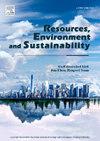三峡库区坡耕地时空演变及侵蚀风险管控区划
IF 7.8
Q1 ENVIRONMENTAL SCIENCES
引用次数: 0
摘要
三峡库区坡耕地是关系到国家粮食安全与生态安全的重要区域。采用地形梯度分类、核密度估算、侵蚀风险识别模型等方法,对1990-2020年青藏高原坡耕地时空演变特征及影响因素进行了分析,并对其侵蚀风险控制区进行了划分。TGRA坡耕地呈现中西部多、东部少、破碎化程度高的空间分布特征。主要分布在坡度为8 ~ 25°、海拔为200 ~ 1000 m的地区,分别约占坡耕地面积的63%和80%。近30年来,坡度为15°和海拔为1000 m的坡耕地分布逐渐减少,分别向8-15°和400-800 m地区转移。坡耕地减少343.93 km2,主要转化为林地、草地、水田和建设用地。坡度和海拔是影响坡耕地时空演变的主要自然因素,城市化率和农村居民可支配收入是影响坡耕地时空演变的主要人为因素。侵蚀高风险等级以上坡耕地主要分布在无锡、开州、巫山、奉节、云阳、万州等县,集中在坡度10 ~ 35°、海拔200 ~ 1000 m的地形梯度区,15 ~ 25°、200 ~ 400 m分布最多。对于这些高侵蚀风险地区,应优先对坡耕地进行治理。研究结果对优化坡耕地资源利用,加强水土流失风险防控,促进农业可持续发展具有重要意义。本文章由计算机程序翻译,如有差异,请以英文原文为准。

Spatio-temporal evolution of sloping farmland and identification of its erosion risk management and control zones in the Three Gorges Reservoir Area, China
Sloping farmland in the Three Gorges Reservoir Area (TGRA) is crucial for national food and ecological security. In this study, methods such as terrain gradient classification, kernel density estimation, and erosion risk identification model were used to analyze the spatio-temporal evolution and influencing factors of sloping farmland in the TGRA during 1990–2020, and its erosion risk control areas were identified. The sloping farmland in the TGRA exhibited spatial distribution characteristics of more in the central and western regions, less in the eastern region, with a high degree of fragmentation. It was concentrated in areas with slopes of 8–25° and altitudes of 200–1000 m, accounting for approximately 63% and 80% of sloping farmland, respectively. In the last 30 years, the distribution of sloping farmland with slopes 15° and altitudes 1000 m has gradually decreased and shifted to areas of 8–15° and 400–800 m, respectively. The sloping farmland has decreased by 343.93 km2, mainly converted into forest land, grassland, paddy field, and construction land. Slope and altitude were the main natural factors affecting the spatio-temporal evolution of sloping farmland, while the urbanization rate and disposable income of rural residents were the key human influence factors. Sloping farmland above the high-risk level of erosion was mainly distributed in counties such as Wuxi, Kaizhou, Wushan, Fengjie, Yunyang, and Wanzhou, concentrated in the terrain gradient area with slopes of 10–35° and altitudes of 200–1000 m, with the most distribution at 15–25° and 200–400 m. For these high erosion risk areas, prioritized regulation should be carried out for sloping farmland. These findings can optimize the use of sloping farmland resources, strengthening the prevention and control of erosion risks, and promoting the sustainable agricultural development.
求助全文
通过发布文献求助,成功后即可免费获取论文全文。
去求助
来源期刊

Resources Environment and Sustainability
Environmental Science-Environmental Science (miscellaneous)
CiteScore
15.10
自引率
0.00%
发文量
41
审稿时长
33 days
 求助内容:
求助内容: 应助结果提醒方式:
应助结果提醒方式:


